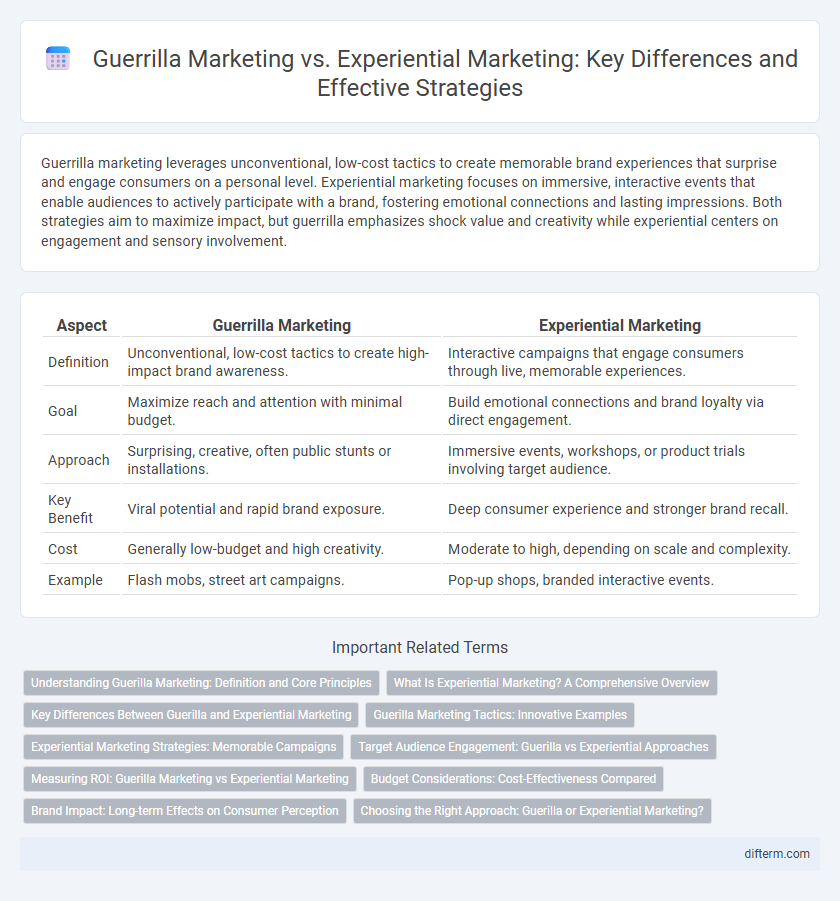Guerrilla marketing leverages unconventional, low-cost tactics to create memorable brand experiences that surprise and engage consumers on a personal level. Experiential marketing focuses on immersive, interactive events that enable audiences to actively participate with a brand, fostering emotional connections and lasting impressions. Both strategies aim to maximize impact, but guerrilla emphasizes shock value and creativity while experiential centers on engagement and sensory involvement.
Table of Comparison
| Aspect | Guerrilla Marketing | Experiential Marketing |
|---|---|---|
| Definition | Unconventional, low-cost tactics to create high-impact brand awareness. | Interactive campaigns that engage consumers through live, memorable experiences. |
| Goal | Maximize reach and attention with minimal budget. | Build emotional connections and brand loyalty via direct engagement. |
| Approach | Surprising, creative, often public stunts or installations. | Immersive events, workshops, or product trials involving target audience. |
| Key Benefit | Viral potential and rapid brand exposure. | Deep consumer experience and stronger brand recall. |
| Cost | Generally low-budget and high creativity. | Moderate to high, depending on scale and complexity. |
| Example | Flash mobs, street art campaigns. | Pop-up shops, branded interactive events. |
Understanding Guerilla Marketing: Definition and Core Principles
Guerrilla marketing is an unconventional advertising strategy that uses low-cost, high-impact tactics to create memorable consumer interactions and maximize brand exposure. It relies on creativity, surprise, and engaging environments to capture attention and generate word-of-mouth buzz. Core principles include originality, targeted messaging, and leveraging public spaces to deliver powerful, immersive brand experiences.
What Is Experiential Marketing? A Comprehensive Overview
Experiential marketing engages consumers through immersive, memorable experiences that create emotional connections with brands. Unlike guerrilla marketing's surprise tactics and unconventional stunts designed for quick impact, experiential marketing focuses on interactive events, product trials, and brand activations that foster deeper customer involvement and loyalty. Key elements include sensory engagement, storytelling, and consumer participation to enhance brand perception and drive long-term advocacy.
Key Differences Between Guerilla and Experiential Marketing
Guerilla marketing relies on unconventional, low-cost tactics to create immediate, high-impact impressions, often surprising audiences in unexpected places. Experiential marketing focuses on immersive, interactive brand experiences designed to engage consumers on a deeper emotional level and foster lasting connections. The key difference lies in guerilla marketing's emphasis on short-term buzz versus experiential marketing's goal of building sustained brand loyalty through meaningful customer interactions.
Guerilla Marketing Tactics: Innovative Examples
Guerilla marketing tactics leverage unconventional, low-cost methods to capture audience attention and generate buzz, such as flash mobs, street art, and viral stunts. Innovative examples include Coca-Cola's "Happiness Machine" vending machine surprise and IKEA's living room setups in public spaces, which create memorable, engaging brand experiences. These tactics rely on creativity and surprise to maximize exposure and foster organic social sharing, enhancing brand visibility without a large advertising budget.
Experiential Marketing Strategies: Memorable Campaigns
Experiential marketing strategies create memorable campaigns by engaging consumers through immersive brand experiences that foster emotional connections and long-lasting impressions. Brands like Starbucks' "Coffee Moments" and Red Bull's extreme sports events demonstrate the power of interactive environments to deepen customer loyalty and amplify word-of-mouth. These campaigns prioritize sensory stimulation and personalized interactions to transform passive audiences into active brand advocates.
Target Audience Engagement: Guerilla vs Experiential Approaches
Guerrilla marketing captivates target audiences through unexpected, unconventional tactics that create memorable brand impressions in everyday settings, maximizing surprise and viral potential. Experiential marketing engages consumers by immersing them in interactive brand experiences, fostering emotional connections and deeper brand loyalty through multi-sensory involvement. Both strategies prioritize audience engagement but differ in focus--guerrilla marketing leverages shock and novelty, while experiential marketing builds long-term relationships through meaningful participation.
Measuring ROI: Guerilla Marketing vs Experiential Marketing
Guerilla marketing often delivers rapid engagement with lower upfront costs, making ROI measurement reliant on immediate metrics like social media interactions and viral reach. Experiential marketing invests more in creating immersive brand experiences, requiring comprehensive ROI analysis through customer feedback, brand recall, and long-term sales impact. Accurate ROI comparison necessitates tracking both quantitative data such as conversion rates and qualitative outcomes like emotional brand connection.
Budget Considerations: Cost-Effectiveness Compared
Guerilla marketing leverages low-cost, unconventional tactics to generate high-impact visibility, making it highly cost-effective for brands with limited budgets. Experiential marketing requires higher investment due to immersive event setups and engaging customer interactions but delivers deeper brand engagement and loyalty. Balancing immediate budget constraints against long-term relationship building is crucial when choosing between these marketing strategies.
Brand Impact: Long-term Effects on Consumer Perception
Guerrilla marketing creates strong immediate impressions by leveraging unconventional tactics that surprise and engage consumers, often leading to high brand recall. Experiential marketing builds deeper emotional connections through immersive brand interactions, fostering lasting loyalty and positive consumer perception. Both strategies enhance brand impact, but experiential marketing typically generates more sustained long-term effects on consumer behavior and brand affinity.
Choosing the Right Approach: Guerilla or Experiential Marketing?
Guerilla marketing leverages unconventional, low-cost tactics to create memorable, high-impact brand interactions, ideal for startups and small businesses seeking rapid visibility. Experiential marketing focuses on immersive, sensory brand experiences that deepen customer engagement and foster emotional connections, making it suitable for brands aiming to build long-term loyalty. Selecting between guerilla and experiential marketing depends on budget constraints, campaign goals, target audience preferences, and desired brand impact duration.
Guerilla marketing vs experiential marketing Infographic

 difterm.com
difterm.com